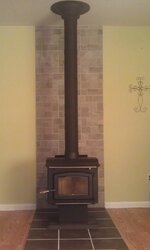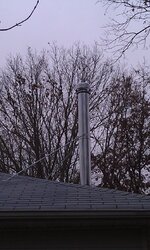Hello all, I am new to wood burning and have recently purchased and installed a US Stove Company APS1100B EPA certified stove. I also installed the chimney which is a supervent insulated chimney system. I pulled a permit and had it inspected. The heat is fantastic! The stove is a little tricky to get going but once it is going, if you keep it hot and use smaller logs, it works well.
That being said, I have noticed lately that my lungs on some days feel a little funny. Could just be the dry air in the house, despite the cast iron kettle on top of the stove. I started researching wood burning health risks and am now quite concerned. I had no idea about the fine particulate matter and how harmful it can be. To help with ash, I bought a shop vac ash vac, which i feel is a bit of a rip off but I will see how it works. I know there are things like this that are heavily one sided, so I wanted to ask you folks, since you have much more experience with this.
Is it the ash or smoke that is the real worry? Is there anything I can do to protect my family? Is it safe once it is burning and door is closed? (Some environmental organizations say that 70% of the smoke particulates re-enter the home with doors and windows closed).
Wow, thank you all for the replies. I do not have a moisture meter but do think my wood is too damp. Someone gave me about 5 cords of oak that was cut into mostly 16 inch logs and stacked for almost 2 years. I have been hauling it home and splitting it with my buddies 27 ton splitter. I think it needs some more time now that it is split. I will have to invest in a moisture meter. I contacted the stove company to ask about the hard lighting and happened to ask if my stove has a secondary burn (doesn't have burn tubes or anything) and they said no. It is an epa certified stove though. I have a magnetic thermometer on the stove top and the highest it has gotten when burning real good was 450 but usually hangs around 300-350. Is that even hot enough to burn right?
Welcome to the forum gmtechguy.
The real dangers of wood burning is some of the poor practices that some folks use and continue to do so. Some can never be taught...
What you are finding is quite normal with new wood burners so you are not alone. Looks like a good install and I would not worry about those trees. We have lots of trees to contend with here but have no problems because of them.
On the dry air, which is no doubt causing that strange feeling in your lungs lately, a humidifier can help that out nicely.
On the shop vac, I'll only add one caution and that is to not remove all the ashes when you do this. Leave at least 1-2" in the bottom of the stove for best results. We usually remove some ashes once per week or maybe sooner in really cold weather but still leave a good amount of ashes in the stove.
Now to the real problem. The most basic problem with new wood burners is being able to get good fuel to burn. As you well know, if you burn poor fuel in your car or truck, you will get very poor performance. It is exactly the same thing with wood stove. So the question becomes, how do we get good fuel?
Most wood burners will cut their own wood. Some have woodlots; some scrounge wherever they can; many have had good luck getting wood from arborists because it costs those folks many dollars to dispose of their wood so they are happy to give it away. Some folks will buy a semi-load of logs and then cut from that. Also, it definitiley pays to learn what types of wood is available in your area and also to know which is best.
So once we get the wood, how do we dry it? First and foremost is that wood will not dry hardly at all until it has been split. It will lose some moisture from the ends but very little. Therefore we need to expose more of the interior of the logs to air so the moisture can evaporate. Once this is done, then the wood needs to be stacked, off the ground and preferably in the windiest spot you have on your place. The biggest key to drying wood is air circulation and that means wind. Sunshine won't hurt either but if I choose between the two, wind always wins. In most cases it also pays to top cover the wood but never cover the sides or ends. Remember, it needs air. Now that you have your wood cut, split and stacked, what you need is time. But how much time?
That depends upon the wood. Generally speaking, the softer the wood, the quicker it will dry. On the other hand, oak is one of the very best. However, it gives up the moisture very reluctantly. Around here, we give it 3 years in the stack before burning it in the stove. It pays great dividends by doing this. Yet there are plenty of woods that will dry nicely within a year. You need to find out what you have in your area and choose some that take only a year to dry.
I also have to second what BrotherBart said on this idea of 70% of the particulates re-entering the home. Pure grade A baloney.
On your stove top temperatures, they are low so don't worry about running it hotter. Especially that your wood is a bit damp, higher temperatures will help you. But one word of caution here. Do check your chimney often. At least monthly. Clean if necessary. Burning wood that is a bit high in moisture can cause a chimney to plug up very quickly; we've seen this done in less than 2 weeks! So please do yourself a favor and keep a sharp eye on the chimney.
Good luck.




